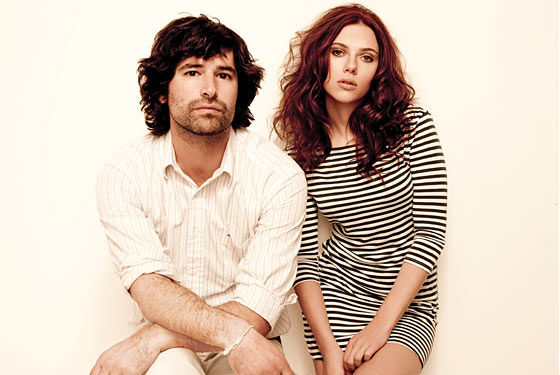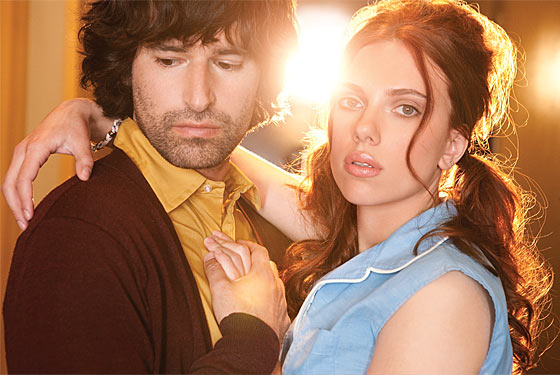
One muted winter afternoon in 2006, Pete Yorn awoke from a sleeplike trance convinced that recording a duets album with Scarlett Johansson would save him. Unlike most people who have this thought, Yorn actually had the actress’s number. The two were acquainted through Yorn’s brother, an entertainment lawyer Johansson has worked with since she was a teenager. So Yorn texted her. Johansson hadn’t yet recorded or even announced her own 2008 album, the slight but likable Anywhere I Lay My Head, a collection of Tom Waits covers. But it turned out to be an opportune moment for both.
Yorn—a singer-songwriter who broke out in 2001 with the CD musicfor themorningafter—had been touring nonstop for months behind his 2006 album, Nightcrawler, and was having a tough time reentering normal life. Johansson was weathering the transition from indie ingenue to grown-up movie star. Though she wasn’t feeling as emotionally vulnerable as Yorn, they shared a common sense of being in between stages in life. Both were restless, had time on their hands, and were ready for a new challenge.
In the early weeks of January 2007, the pair met at an unassuming studio in Los Angeles and recorded Break Up, a collection of boy-meets-girl-girl-ruins-boy duets in the tradition of Serge Gainsbourg and Brigitte Bardot, Lee Hazlewood and Nancy Sinatra, and Lou Reed and Nico. Intuition spawned the idea and improvisation fueled the album’s production; Yorn, 35, and Johansson, 24, felt the magic would come from the willfully haphazard way it was recorded.
Nearly three years, two solo albums (one his, one hers), a Woody Allen movie (hers), and a wedding (also hers) later, and Break Up is finally coming out (September 15 on Atco; the first single, “Relator,” was released in May, on vinyl and iTunes). The result—a delicate, elegiac album of jangly country-tinged songs about love gone wrong—is like the perfect mix tape for anyone haunted by an ex.
This record was inspired by a dream?
PY: Sort of. I was home in Jersey for Christmas break after touring, and I just freaked out. I had all this anxiety, and I wasn’t sleeping. One afternoon, I curled up on the bed, trying to pass out. I was jolted awake by one of those Oh my God, I left the oven on or I’m late for school feelings. Except it was I gotta make a duets record. This quick flurry of thoughts came together over a few seconds: Duets record, yeah! Guy-girl thing, yeah! Serge Gainsbourg, Brigitte Bardot—they’re cool, I love them … Brigitte Bardot … Scarlett Johansson! Just a total chain reaction.
SJ: I don’t even think he knew that I could sing. I think he asked me after I said I would do the album.
PY: I had a phone number for her from a few years earlier. I texted her not even knowing if it was still her number.
SJ: It didn’t strike me as strange to get his message. I hadn’t spoken to him in a long time, but we’ve always had a friendship where we catch each other every few months and it’s like no time has passed. That said, we had never talked about music.
PY: She hit me back like, “That sounds cool. Let’s do it!” Then I was like, um, now what? Before you knew it I was writing songs and we were in the studio making the tracks. Two months later, we had Scarlett come in for two afternoons.
Scarlett, at that point you hadn’t made a record before. What gave you the confidence to step into a recording studio?
SJ: I’ve been singing for my whole life. When I was a kid I wanted to be on Broadway—I was a real jazz-hands kind of girl.
PY: Her voice is like mine—it’s not technically perfect, it’s quirky.
SJ: It sort of happened by fluke that we could actually sing together.
PY: When Scarlett came in, she gave the album a huge presence without even trying. She played the part of the female perspective in the songs—she brought an aloofness I hadn’t accounted for.
Did Pete send you the songs as he wrote them?
SJ: No, I had no idea what the songs were going to sound like when I got to the studio.
PY: The album cover is a photo my cousin took of me showing her a song right before we recorded it. If she wasn’t singing and I wasn’t singing, that’s what we were doing, sitting there with the guitar, like, Okay, here’s the song. Learn it.
SJ: A lot of the work we did was just collaborating on the harmonies. Finding them and figuring out who would sing which piece. I didn’t expect to sing “I Am the Cosmos” by myself. But Pete preferred it with a female voice, so that became a bit of a solo.
PY: She ended up having a deeper voice, so I took a lot of the light, higher stuff.
SJ: Pete had mentioned the Serge and Brigitte recordings, and I had my own idea that it was Nico-ish, but it wasn’t like we talked it all through. The songs are quite literal, so we weren’t trying to find the meaning in them; the meaning is very much there.

Musically, Break Up is more lovelorn Americana than pouty French pop. Is it meant to be pure homage?
PY: This record is like two innocent kids compared to that classic, sexy French shit. Never in my dreams would I want to suggest that we could pull off that level of sensuality.
SJ: Pete has so uniquely captured that sixties-French-pop period without it being retro. When you listen to music that’s “inspired” by a certain era, more than hearing the inspiration you hear a bad impression. This album is more of a valentine to that period than an imitation.
You made Break Up nearly three years ago; why wait so long to release it?
PY: I went on tour. She did movies. Every once in a while Scarlett would late-night text me: “We’re listening to the record, we love it!” So I’d kind of check it out too and be like, “Yeah it does sound pretty fun.” After living with it for a while, I really love the album. It’s the sound of this one moment in time.
SJ: Absolutely. Both of us were in a transient place. I’ve been working since I was 8 years old, and whenever I have periods of time when I don’t have to be doing anything, where I don’t have any responsibility, it’s in those moments that I live my life. I felt, as the word transient would suggest, in between two places. In between a beginning and an end. And I think Pete also had that feeling of being in between, of being everywhere and nowhere at once.
Any chance fans will be able to hear the songs live?
SJ: I’ve never been one to hawk something. If people demand it, maybe we’ll do a couple of shows in Europe and a couple of shows here. I have terrible stage fright, so it would be a challenge for me, but I’ve got to face that eventually. The album sounds nice out loud.
Did making the album cure your insomnia, Pete?
PY: No. That took a couple of years. Every day in the studio was hard for me—I was in an acute anxiety state. But I surrounded myself with really good people, and there was a power between us that I guess was just bigger than whatever my anxiety was. The odd thing is that when I listen to the album now, it sounds like some of my happiest music ever. When “Relator” comes on, it puts a smile on my face every time—it sounds so fun.